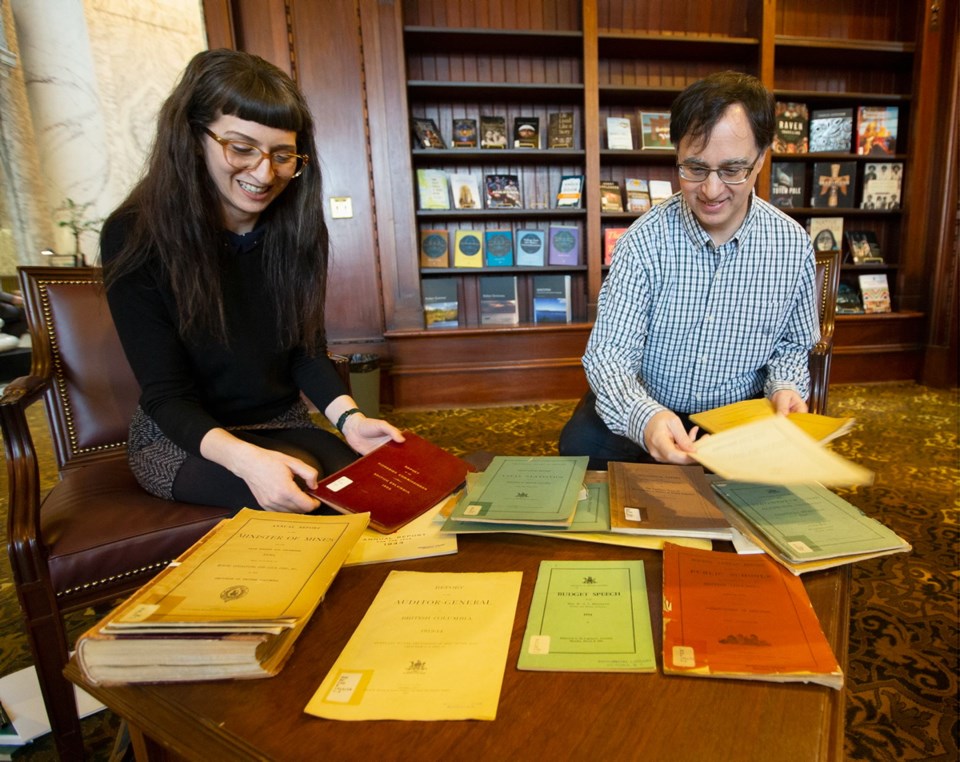The Legislative Library of B.C. is seeking a contractor to digitize thousands of publications in order to preserve historica materials and make them accessible online to anyone.
It’s the second phase of a project to digitize government books and reports dating from 1871 to 1947.
The library holds about 500,000 books and of those, about half are B.C. government publications. Only provincial publications are being digitized.
Saved on shelves spanning six storeys is “by far, the largest collection of B.C. government publications anywhere,” library director Peter Gourlay said.
“Those publications tell one of the histories of the province — which is the history of the province as told through the actions and publications of the government.”
Anything published publicly by B.C. was saved. Gourlay holds up a mottled 1893 contract with carpenters and joiners for work on what was then called the new parliament buildings, designed by architect Francis Rattenbury.
A B.C. Museum report by the late zoologist and conservationist Ian McTaggart-Cowan, published in 1939, examined the vertebrates of the Peace River district. Other examples include an early budget speech from Premier W.A.C. Bennett and a thin 1901 statement of births, deaths and marriages.
Stepping into the library is like stepping back to a time of marble and ornate wood, silence and card catalogues.
The most precious materials do not leave the library, Gourlay said. The library has a rare-book vault for treasures that are not necessarily related to B.C. It has an early literature collection featuring books by English playwrights and poets William Shakespeare and Ben Jonson dating from the 1600s.
Aside from those tantalizing items, the B.C. collection is made up of annual reports, books filled with estimates and much more. In the early days, departments would typically issue just one report per year, filled with all their statistics.
Digitizing materials and putting them online fulfills the library’s responsibility to preserve the collection and to provide access to it, Gourlay said.
“We put them up on our website and then anyone in the province can use them so they are all publicly available.”
Digital materials are full-text searchable, meaning users can look for a key word to help narrow down a search.
Universities and colleges are loading the digital information for their students to use as well, he said.
“The materials are older. They are not in great condition a lot of the time. So by digitizing, that means people can use the digital copy rather than the print copy, so that helps to preserve the print copy,” Gourlay said.
The library’s primary purpose is to provide information and research services to MLAs, their staff and other government researchers.
About eight years ago, the library started collecting material in a digital format and it continually adds new publications.
As a result of a previous three-year contract that ended in 2018, several thousand publications dating from 1871 to 1947 were digitized. It’s hoped the next contract will finish that job.
A request for proposals to carry out the work closes on May 31. It is valued at up to $110,000 for four years of work, with a one-year option to extend.
Materials leave the building to be scanned. “We have had good success with everybody we have dealt with,” Gourlay said.
[email protected]AKING CONNECTIONS
• The library remains open for MLAs and staff working in the legislature building, but is closed to the public.
“The library is operating with reduced staff onsite, and most staff [are] working from home. Services remain unchanged as much as possible,” said technical services librarian Sheri Ostapovich via email.
• Citizens can connect with the library by going to [email protected].
The library provides reference services via email, which clients are being encouraged to use.



